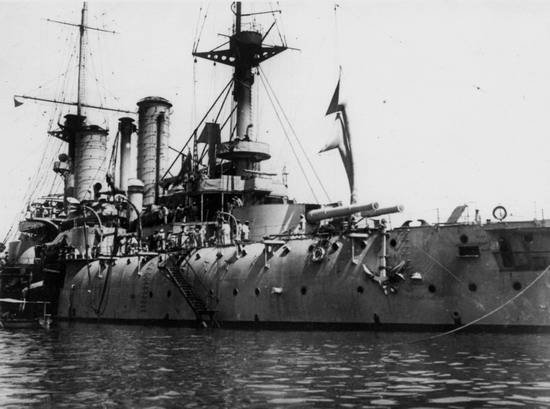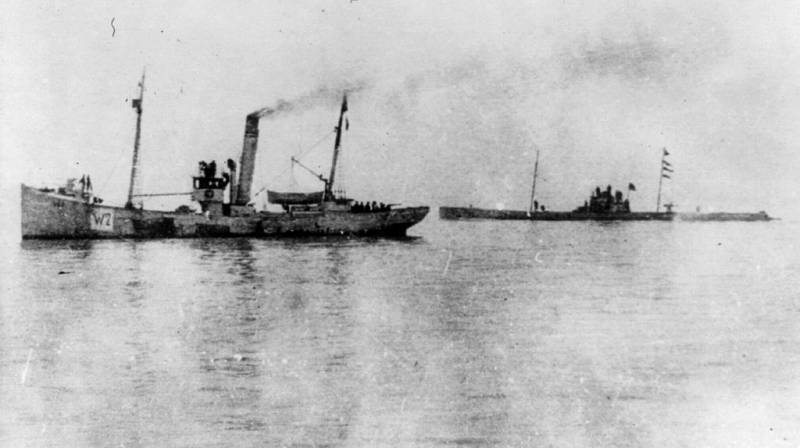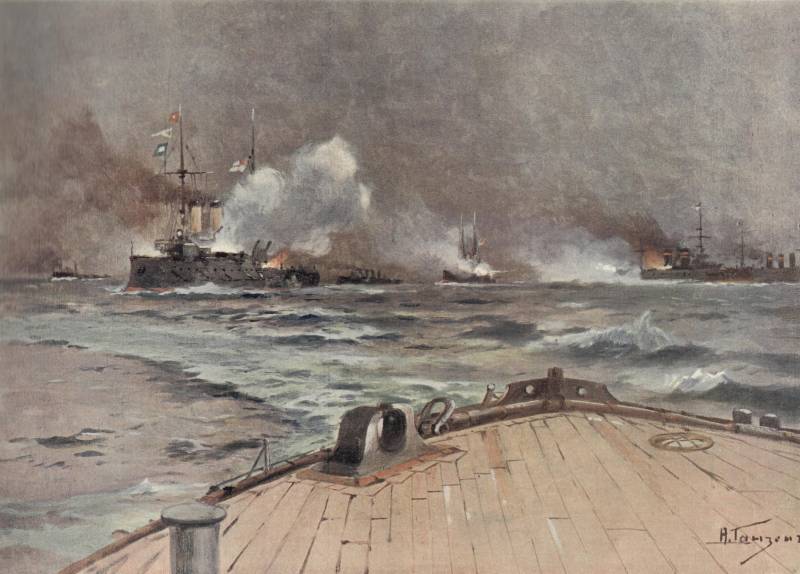Russian fleet in the First World War and its combat effectiveness. Part of 5
All this required the involvement of large resources, the lack of which was the reason that their implementation was delayed. The reconstruction of the Arkhangelsk-Vologda railway ended in January 1916, and the construction of the Murmansk road was completed in 1917. Observation posts were set up in the throat of the White Sea, and a battery of 4-47-mm guns was installed on Mudyug Island.
Already at the end of 1914, the enemy began to lay mines, and at the beginning of the navigation of 1915, the German command sent an auxiliary cruiser, Meteor, into the throat of the White Sea - he put 285 mines. A number of merchant ships died on the mines and the British auxiliary cruiser Arlanz was blown up. Since June 1915, the defense of the Arkhangelsk port and the protection of maritime communications in the theater of operations have become more organized and effective.
In July 1916, an order to form flotilla Of the Arctic Ocean. The flotilla was supposed to include a cruising detachment, a trawling division, defense units of the Kola Bay, Arkhangelsk port, as well as a communications and surveillance service. The main tasks of the flotilla are: escorting ships in mine-hazardous areas, security, sentinel service, coastal defense.
In 1916, the construction of a base began in the depths of the Kola Bay - near the Semenovye Islands. A trade port was built in the Kola Bay near the village of Romanov (the future Murmansk).
The German command, assessing the importance of the northern maritime communications that linked Russia with its allies on the Entente and neutral states, sent submarines in the second half of 1916 for active operations in this theater. In August and September, German submarine minzagi installed 72 mines at the entrance to the throat of the White Sea - several ships were killed. Since September, 1916, enemy submarines began to appear on the outskirts of the Kola Bay.
The Russian command took measures on anti-submarine defense, reducing the losses to a minimum by October.
In the 1917, in the composition of the fleet of the Arctic including: Battleship ( "Chesma"), 2 cruiser ( "Varyag" and "Askold"), 4 destroyers, destroyer 2, 3 submarine minelayer, 40-trawlers and trawlers boats 2 icebreaker and up to 20 auxiliary ships.

1. "Chesma".
In the North Sea Theater, the enemy lost 3 submarines: U 56 (sunk by the destroyer Thunderstorm), U 76 (destroyed by minesweepers) and U 28 (killed by an explosion of attacked vehicles with military cargo).
2. U-28 in 1915 from the seized vessel.
The young fleet declared itself in full voice.
In 1917 on the Black Sea, the fleet continued fighting on enemy communications, making it difficult to deliver weapons and food of the Turkish army on the Caucasian front, shelling coastal objects, blocked the Bosphorus.
The main event for the Baltic Fleet weakened by the revolution in 1917 was the participation in the Moonsund operation.
The final contribution of the Russian fleet to the victory of the Entente is expressed in the following figures (See: Aleksandrov, Yu. I. Domestic submarines before the 1918 of the year (reference book). SPb., 2002; Apalkov, Yu. V. Warships of the Russian fleet 08. 1914 10. 1917. Reference book. St. Petersburg, 1996; It is the German Navy 1914-1918. Reference book on the ship composition // Maritime collection. 1996. No. 3; Ozarovsky N. Yu. -1914 M.-L., 1917; Puzyrevsky KP Ship damage from artillery and the struggle for survivability. L., 1941; Puzyrevsky K. P. Damage orablay from underwater explosions and the struggle for survivability. L. - M., 1940; Pakhomov N. A. Armored cruisers of Germany. 1938-1886. Samara, 1918; Trubitsyn S. B. Light cruisers of Germany (2006-1914). Spb., 1918; It is the same. German destroyers and destroyers (1997-1871). Spb., 1918; Russian Imperial Navy and German and Turkish fleets. Pg., 2000; N. Khromov. Submarine forces of the Baltic Fleet 1915 -1906. Kaliningrad, 2006); Shishov A. A. German Navy losses in World War I 2006-1914 SPb., 1918).
Destroyed enemy ship, cause and date of death, theater, operation
"Magdeburg", light cruiser - 13. 08. 1914, sat on the stones of about. Odenholm, blown up by the crew and finished off by the cruisers Bogatyr and Pallada, 15 people died. 1914, Baltic.
"Gerda", auxiliary patrol ship - 16/08/1914, mine explosion. 1914, Baltic.
"Temesh", the monitor - 10. 10. 1914, a mine explosion on the river. Savva, killing 31 people. 1914, Danube Theater.
"Augustenburg", auxiliary patrol ship - 21. 10. 1914, mine explosion, 6 people died. 1914, Baltic.
"Friedrich Karl", armored cruiser - 4. 11. 1914, mine explosion near the Danzig Bay, 7 people died. 1914, Baltic.
Blocks “Elfie”, “Julia”, “Marta”, “Martial” - 4. 11. 1914 flooded by the crews at Libava. 1914, the Baltic.
"Nilufer", mine layer - 6. 11. 1914, explosion on a mine. 1914, Black Sea.
"Ron", mine layer - 17. 12. 1914, explosion on a mine. 1914, Black Sea.
"Hohenzollern", tug - 03. 01. 1915, mine explosion, 16 people died. 1915, Baltic.
"Gazelle", light cruiser - 12. 01. 1915 decommissioned after being blown up by a Russian mine. 1915, Baltic.
"Nevsehir", gunboat - 17. 01. 1915, mine explosion 1915, Black Sea.
"Medzhidie", light cruiser - 21. 03. 1915, mine explosion near Odessa 1915, Black Sea.
T 57, minesweeper (ships of the T43 type were called destroyers-sweepers. Depending on the tasks in the operation, when the ship died, we call it either a destroyer or a minesweeper. Of the 12 ships of the series, 10 were killed by Russian weapons) - 23. 03. 1915, undermining on a mine 1915, Baltic.
T 47, minesweeper - 16. 05. 1915, undermining the Amur minzag on a mine, 20 people died. 1915, Baltic.
T 51, minesweeper - 16. 05. 1915, undermining the Amur minzag on a mine, 20 people died. 1915, Baltic.
"Gzinder", hydro-air transport - 21/05/1915 was blown up by a mine and disarmed. 1915, Baltic.
"Dora Hugo Stinnes 12", fleet collier - 23, sunk by British submarine. 05, Baltic.
"Bunte Kuh", minesweeper - 15/06/1915, explosion on a mine, 1 person died. 1915, Baltic.
"Ursula Fischer", transport - 18/06/1915, undermining Russian destroyers on a mine. 1915, Baltic.
"Albatross", mine cruiser - 19/06/1915, after a battle with Russian cruisers, she threw herself ashore on the island. Gotland, 28 people died. 1915, Baltic, Gotland battle
V 107, small destroyer - 26. 07. 1915, explosion on a mine near Libava. 1915, Baltic.
T 52, minesweeper - 26. 07. 1915, mine explosion 1915, Baltic Irben operation.
T 58, minesweeper - 26, explosion on a mine, 07 people died. 1915, Baltic Irben operation.
T 46, minesweeper - August 03, 08, mine explosion, 1915 people killed. 17, Baltic, Irbe operation.
V 99, destroyer - 04. 08. 1915, was killed in the Gulf of Riga (during an artillery battle with the destroyer "Novik" he was severely damaged and forced to leave for a minefield), 21 people died. 1915, Baltic, Irben operation.
S 31, destroyer - 06. 08. 1915, mine explosion 1915, Baltic, Irben operation.
Blockships "Oak", "City of Berlin", "Iris" - 07. 08. 1915, flooded near the city of Pernov. 1915, Baltic, Irben operation.
"Breslau", transport - 24. 08. 1915, explosion on a Russian mine in the Gulf of Danzig. 1915, Baltic.
"Vilkomen", fleet tanker - 30. 09. 1915, mine explosion 1915, Baltic.
U 26, submarine - 09. 1915, explosion on a mine, 30 people died. 1915, Baltic.
"Prince Adalbert", armored cruiser - 10. 10. 1915, torpedoed by the English submarine E-8 near Libau, 672 people died 1915, Baltic.
"Undine", light cruiser - 25. 10. 1915 was sunk by submarine E-19, 14 people died. 1915, Baltic.
A 3, destroyer - 25. 10. 1915, mine explosion 1915, Baltic.
"Burgmeister Petersen", fleet tanker - 29. 10. 1915, mine explosion 1915, Baltic.
"Norburg", patrol ship - 7. 11. 1915, as a result of a raid by Russian destroyers. 1915, Baltic.
“Tashkentopru”, gunboat - 27. 11. 1915, artillery fire of destroyers. 1915, the Black Sea.
"Yozgat" gunboat - 27. 11. 1915, artillery fire of destroyers. 1915, the Black Sea.
UC 13, the submarine - 15. 11. 1915 a storm threw ashore, finished off by Russian ships. 1915, Black Sea
"Bremen", light cruiser - 4. 12. 1915, explosion on a Russian mine, 250 people died. 1915, Baltic.
S 191, destroyer - 4. 12. 1915, mine explosion. 1915, Baltic.
S 177, large destroyer - 10. 12. 1915, mine explosion 1915, Baltic.
"Freya", patrol ship (former cruiser) - 10. 12. 1915, explosion on a Russian mine, 22 people died. 1915, Baltic.
"Bintz", patrol ship - 12. 1915, mine explosion. 1915, Baltic.
G 194, large destroyer - 13. 03. 1916, mine explosion 1916, Baltic.
"Hamburg", Luger - 01. 05. 1916, mine explosion 1916, Baltic
"Hermann", auxiliary cruiser and 2 armed trawlers 18/05/1916, sunk by torpedoes in a battle with destroyers, 40 people died 1916, Baltic, battle in Norrköping Bay
U 10, submarine in May 1916, mine explosion, 30 dead 1916, Baltic
Trap ship N 01. 06. 1916, sunk by the destroyer Novik 1916, Baltic
V 162, large destroyer 02, mine explosion 08, Baltic
"Siemens Shukert" 2, motor boat 27. 08. 1916, explosion on a mine, 10 people died 1916, Baltic
"Shumni", destroyer 29. 08. 1916, explosion on a mine near Varna 1916, Black Sea
"Kutakhia", destroyer 01. 09. 1916, mine explosion 1916, Black Sea
"Malatya", gunboat 04. 09. 1916, mine explosion 1916, Black Sea
T 64, minesweeper 10. 10. 1916, mine explosion 1916, Baltic
F 2, minesweeper 25. 10. 1916, explosion on a mine in the Irben Strait 1916, Baltic
"Erkner"1, motor boat 25. 10. 1916, explosion on a mine in the Irben Strait 1916, Baltic
S 57, destroyer 29. 10. 1916, mine explosion, 2 people died 1916, Baltic. Operation of the 10th mine flotilla to break into the Gulf of Finland
V 75, destroyer 29/10/1916, mine explosion, 3 people killed 1916, Baltic. Operation 10th Flotilla
S 58, destroyer 30. 10. 1916, mine explosion 1916, Baltic. Operation 10th Flotilla
S 59, destroyer 30. 10. 1916, mine explosion 1916, Baltic. Operation 10th Flotilla
V 72, destroyer 30. 10. 1916, mine explosion 1916, Baltic. Operation 10th Flotilla
V 76, destroyer 30. 10. 1916, mine explosion, 1 person died 1916, Baltic. Operation 10th Flotilla
G 90, destroyer 30. 10. 1916, mine explosion, 11 people died 1916, Baltic. Operation 10th Flotilla
U 56, submarine 20, destroyed by a destroyer, 10 people died 1916, Northern Maritime Theater (Barents Sea)
UB 45, submarine 24, explosion on a mine near Varna 10, Black Sea
UB 7, submarine 10. 1916, destroyed by Russian seaplane, 15 dead 1916, Black Sea
UC 15, small underwater mine layer 11. 1916, explosion on a mine, 15 people died 1916, Black Sea
Patrol boats No. 12 and No. 16 8. 12. 1916, by the fire of the cruiser "Memory of Mercury" near the Bosphorus 1916, Black Sea
UB 46, submarine 26. 11. 1916, killed by mines laid by TSCHK 234, 20 people died 1916, Black Sea
U 76, submarine 12, sunk by artillery of surface ships, 01 dead 1917, Northern Sea Theater (Barents Sea)
U 28, submarine 20. 08. 1917, during the attack of transport, 28 people died 1917, Northern Marine Theater (White Sea)
"Neitzleichter" V, net lighter 15/09/1917, mine explosion, 13 people died 1917, Baltic
T 54, destroyer 23. 09. 1917, explosion on a mine, 7 people died 1917, Baltic
M 31, minesweeper 25. 09. 1917, mine explosion, 2 people died 1917, Baltic, operation "Albion"
Destroyer type "S" "Dolphin" 01. 10. 1917, mine explosion, 22 people died 1917, Baltic, operation "Albion"
Destroyer type "S" "Altair" 01. 10. 1917, mine explosion, 10 people died 1917, Baltic, operation "Albion"
S 64, destroyer 04, mine explosion, 10 people died 1917, Baltic, Operation Albion
T 66, destroyer 05 - killed by mines in the Gulf of Riga 10, Baltic, Operation Albion
T 54, destroyer 06. 10. 1917, mine explosion 1917, Baltic, operation "Albion"
T 56, destroyer 03. 10. 1917, died from artillery fire, thrown ashore 1917, Baltic, operation "Albion"
Roland III, minesweeper 08, explosion on a mine, 10 people died 1917, Baltic, operation "Albion"
Destroyer type "S" "Gutgeil" 09. 10. 1917, mine explosion 1917, Baltic, operation "Albion"
"Glukstadt", destroyer type S 09. 10. 1917, washed ashore 1917, Baltic, operation "Albion"
F 3, minesweeper 11. 10. 1917, mine explosion 1917, Baltic, operation "Albion"
A 32, destroyer 12. 10. 1917, mine explosion 1917, Baltic, Operation Albion
"Tarask", minesweeper 13. 10. 1917, capsized and sank 1917, Baltic, operation "Albion"
"Kibweider", destroyer type S 13. 10. 1917, washed ashore 1917, Baltic, operation "Albion"
M 68, minesweeper 16. 10. 1917, mine explosion, 1 person died 1917, Baltic, operation "Albion"
"Bine", minesweeper 17. 10. 1917, shot, sunk 1917, Baltic, operation "Albion"
T 65, destroyer 13. 10. 1917, mine explosion 1917, Baltic, operation "Albion"
"Hamidabad", destroyer 17, sunk by a joint attack of seaplanes and destroyers off the port of Inada 10, Black Sea
"Skardsay", transport 3. 11. 1917, mine explosion 1917, Baltic
"Marta", transport 6. 11. 1917, mine explosion 1917, Baltic
"Neva", transport 6. 11. 1917, mine explosion 1917, Baltic
UC 57, underwater mine layer 11. 1917, mine explosion 1917, Baltic
Clydelley, transport 1917, sunk by Russian submarine 1917, Baltic
3. Sea battle
To be continued


Information